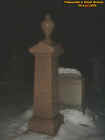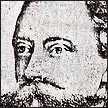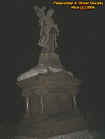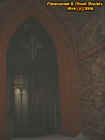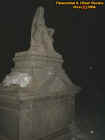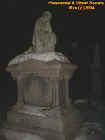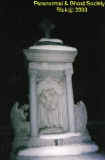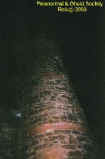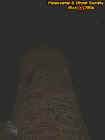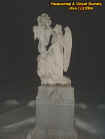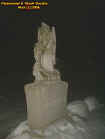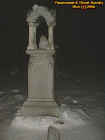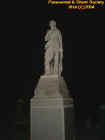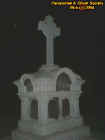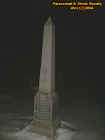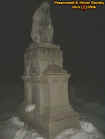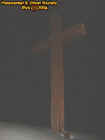| |
Holy Sepulchre is the largest cemetery with over
332 acres, over 10,000 crypts, over 200,000 burials, a chapel, bell tower,
lakes, streams, rod iron gates, castle like entrance in the front and
woods. The cemetery was established in 1871because there was very
little cemeteries dedicated for catholic use. On one side of the road is a
older Victorian section with many angel statues and saints and on the
other side a much newer section. The cemetery is so large that even deer
roam it its trails. So this is just a little bit of information just to
give you perspective on the size. As a paranormal investigator you could
spend hours just walking around and see something probably new every time.
On the property alone you have a shrine, garden section, an all saints
mausoleum and acres of crypts.
But what really intrigued me was the fact that
Jack The Ripper a legend known for a over a century is said to be buried
here. Also known as Dr. Francis Tumuelty, Tumblety, Tumilty, Tumialty, and
Tumathy the first American serial killer. Nobody was sure how his name was
spelled since a century ago names were spelled many different ways as Jack
The Ripper had a large family with many different spellings for the last
name so this is why I have chose to list them all.
Some say Jack The Ripper was a demon some say
a madman others say a mastermind. Below you will find a little bit of
history on how Jack the ripper ended up being buried in Rochester and a
little bit of historical facts. I believe that I captured him on film I
also believe that this is one of the most power entities I ever
encountered there is so much energy maybe some would fear him because
perhaps he was a negative man or as some would say very evil. But to have
him walk up to me from behind as I spoke to him was an accomplishment many
will never achieve. What makes this murderer a legend? Maybe its people
such as myself as even though he is deceased he is still very much alive
such as movies that are made like the one called From Hell, books written
and even paranormal investigations such as this one. Of course many things
get mistranslated so I want to tell the truth story here. What kind of
entity Jack the Ripper is I am not sure other ghost seemed to be around
him maybe his victims maybe his other family members which are buried at
the family plot. But you will see that Jack is back and I made history
with some of the best apparition shots you will ever see. But the question
is what makes a man become a monster is this the real Jack The Ripper?
Some say the reason for his actions were that his mother was a harlot and
this angered him or rather caused him to despise women. But wherever this
man went it is a fact that serial killings did occur.
Many other prominent guest also are buried at
the cemetery below you will find a listing taken from the Holy Sepulchre
website. Some of these stones I encountered but with the list you can see
that this cemetery contains many well known burials in Rochester as well
as probably ghost.
Bishop Bernard McQuaid - First Bishop of Rochester & Founder of Holy Sepulchre Cemetery 1868-1909
Bishop Thomas Hickey - Bishop of Rochester from 1909-1928
Bishop J. Francis O'Hern - Bishop of Rochester from 1929-1933
Bishop James Kearney - Bishop of Rochester from 1937-1966
Auxiliary Bishop John McCafferty
Auxiliary Bishop Dennis Hickey
Rt. Rev. Msgr James Hartley -First Rector of St. Bernards Seminary from 1893-1923
Mother Hieronymo O'Brien - Founder of St. Mary's Hospital
Patrick Barry - Horticulturist
Al Sigl - Broadcaster and Humanitarian
James Cunningham - Founder Cunningham Motor Car Co.
Catherine DeValera Wheelwright - Mother of Eamon DeValera Former Premier of Ireland
Lawrence Ennis O.B.E - International Bridge Builder
Colonel Patrick O'Rorke - Lead Charge at Little Round Top, Gettysburg
Ralph Quattrociocchi - New York State Senator
Mary Louise Brooks - Silent Film Star
Peter "Rattlesnake Pete" Gruber - Eccentric Curator of Rochester's "Hall of Wonders"
In conclusion you can only imagine the journey
an adversity I faced as I scaled the wall and hiked threw snow and ice to
bring you a story on such a large cemetery. Out of dozens of cemeteries I
have visited this one seems to be one of the most haunted. There are
places here so dark you cannot even see your hand in front of your face.
But perhaps what is most eerie about it is the castle like entrance on the
older side then upon entering you come up to a European chapel where along
side it is 100s of priests and bishops graves it looks like something you
would see out of a horror film totally amazing. So now that I have your
attention walk with me into one of the most haunting cemeteries in the
country as you are about to see some things that go beyond human
comprehension.
© By
Rick-AngelOfThyNight
Holy Sepulchre History
Holy Sepulchre Cemetery, now over a 125 years
old, was an early creation of the first bishop of Rochester, Bernard J.
McQuaid (1823-1909). Installed as bishop on July 16, 1868, he dedicated
the cemetery in 1871.
THE BEGINNINGS
The First Catholic parish in Rochester, St.
Patrick's, opened in 1823, had a small downtown graveyard which it quickly
outgrew. After that, local Catholics bought burial space in the common
cemeteries until 1839, when a second St. Patrick's Cemetery of twenty-one
acres was blessed on Pinnacle Hill, on the south side of the city. Even
though this belonged to St. Patrick's Church, it served all the local
"Irish" parishes. Four German Catholic parishes acquired their
own cemeteries. SS. Peter & Paul's on Maple Street, had six acres, and
dated from 1844. St. Joseph's, East Main Street at Goodman, was a fifty acre
tract opened in the 1850's. St. Boniface', on South Clinton Street near
the Pinnacle, was a small two-acre cemetery opened in the 1860's. Holy
Family, also on Maple Street, was a four-acre cemetery, opened in 1864.
Shortly after his arrival in Rochester, Bishop
McQuaid decided that having five local cemeteries was both impractical and
inappropriate. He therefore determined to start a single Catholic burial
ground that would serve for decades to come the needs of local Catholics
of every nationality.
Early in 1871, the Bishop secured a tract of
farm land on both sides of Charlotte Boulevard (now known as Lake Avenue).
It was four miles from downtown Rochester. He paid $200 per acre for the
110 acre plot, but this flat, sandy, riverside land was ideally suited to
his purpose. Having chosen "Holy Sepulchre" as the name for the
new cemetery, he solemnly consecrated one east-side section on September
10, 1871. An estimated 10,000 people attended the consecration, an
indication of how well the Catholics of Rochester thought of the project.
Eight days later the first burial took place: Claude Martin Duffy, the
child of a prominent Rochester couple, Walter and Theresa O'Dea Duffy.
According to the initial plans, 5,000 bodies were soon transferred from
other Catholic graveyards to this new cemetery. However, the last of the
transfers would take place only in the 1950's.
A PLACE OF BEAUTY
Bishop McQuaid, ever a careful planner, saw to
it that the new cemetery started off with the proper managerial policies
and environmental standards so necessary to maintain order and beauty in a
cemetery.
First of all, Holy Sepulchre Cemetery was
incorporated as a religious corporation by an Act of the New York State
Legislature on April 24, 1872. The directors of the corporation were to
include the bishop, his vicar general, a few pastors and several laymen.
Bishop McQuaid had already studied the rules of Calvary Cemetery in New
York, Holyhood Cemetery in Brookline, Massachusetts, and Mt. Elliott
Cemetery in Detroit. From these, with some local additions, he formulated
the rules and regulations, as well as the pricing structure for land and
services. One of the more interesting rules was the limitation to twelve
of the number of carriages for each funeral. This was done to avoid
worldly show; strict, but quite a bit more liberal than the policy of
McQuaid's predecessor, Bishop Timon of Buffalo, who had allowed only six
carriages.
HOLY SEPULCHRE TODAY
Holy Sepulchre Cemetery continues to be the
largest and most active of Rochester cemeteries, comprising 332 acres. The
rate of interments progressed from 780 in 1886, to 1026 in 1900; 1675 in
1940; 2217 in 1960; 1882 in 1980 and approximately 1800 per year in the
1990's. The moderate decline since 1960 is attributable to the fact that
the Diocese of Rochester now permits Catholics to be buried in general
cemeteries.
Under a succession of able managers following
Pierre Meisch, the cemetery has been kept in good trim. In more recent
years new and innovative burial sections have been added, the cemetery
office building has been enlarged and renovated, and a new Operations
Building erected. When Archbishop Mooney was bishop of Rochester, he
authorized the building of a new bishops' crypt in the base of the chapel
tower. Dedicated in 1938, it houses today the remains of Bishop McQuaid,
Bishop Thomas F. Hickey, Bishop John F. O'Hern and Bishop James E.
Kearney. A granite slab set up outside this crypt carries the coats
of-arms of these four bishops and of the two who were buried elsewhere:
Cardinal Edward Mooney (1933-1937), interred in Plymouth, Michigan; and
Archbishop Fulton J. Sheen (1966-1969), interred in St. Patrick's
Cathedral, New York City. The most recent addition to the chapel grounds
is the bronze statue of the founder, Bishop McQuaid, the work of the
Joseph Sibbel Studios, This statue, a gift of the priests of the diocese,
was unveiled at St. Bernard's Seminary on October 16, 1930. St. Bernard's
was closed in 1981 and the statue was re-erected in the cemetery in 1982.
Most Notable among the recent structures are
the Resurrection Garden and All Saints Mausoleums. They were constructed
by the J.C. Milne Company of Portland, Oregon with Robert Monahan, of
Rochester was the consulting architect. The faceted glass windows and the
mosaic cross are the work of the Pike Stained Glass Studios of Rochester.
The first structure was completed in 1978 and building continues as
additional space is needed. To date over 10,000 crypts have been built.
The original building in Resurrection Garden Mausoleum includes 6 crypts
in the tower for bishops. One of them contains the remains of John E.
McCafferty Auxiliary Bishop of Rochester, 1968-1980 .
In 1994, the beautiful Garden of the Sepulchre
was created at the Lake Avenue entrance. This feature area which includes
walking paths lined by the Stations of the Cross is intended to clearly
identify Holy Sepulchre as a Catholic Cemetery.
PURPOSE ACHIEVED
Prominent Rochesterians buried in Holy
Sepulchre Cemetery include: Patrick Barry, horticulturist; Mother
Hieronymo O'Brien, founder of St. Mary's Hospital; Col. Patrick Henry
O'Rorke, Gettysburg hero; Al Sigl, noted broadcaster and humanitarian;
Lawrence Ennis O.B.E., international bridge builder; and Catherine
DeValera Wheelwright, mother of Eamon DeValera, premier of Ireland. Most
of those interred, however, are just "every-day" Catholics who
await in faith the resurrection of the dead.
That is what Bishop McQuaid foresaw and
desired. As he said in 1871 "The intention is to make the cemetery of
the Holy Sepulchre such a one as the whole Catholic body of Rochester will
be proud of as the last home of their deceased family and friends."
Indeed, this lovely cemetery is one in which
all Rochesterians can take justifiable pride.
Jack The Ripper
Information
FRANCIS TUMBLETY
(1833-1903)
A more recent suspect emerged in Evans and Gainey's 1995 book, Jack the Ripper: First American Serial Killer. He was born either in Canada or Ireland in 1833. The family found its way to Rochester, NY by 1849.
First reports of Francis are not promising. In 1848 he was described by neighbors as "a dirty, awkward, ignorant, uncared-for, good-for-nothing boy...utterly devoid of education." In 1850, he moved to Detroit and set up a practice as a physician sometime later. There is no indication that he ever finished school or even attended medical school. Despite that detail, he became quite a prosperous doctor.
The portrait of Tumblety which appeared on the front cover of his second booklet, 1889
He moved all across North America setting up various medical practices and living in flamboyant splendor. Occasionally he would run afoul of the law and would set up his practice somewhere else. At one point he went to Liverpool in 1874 and carried on a homosexual affair with Sir Henry Hall Caine. When he returned to New York, he became known for his "mania for the company of young men and grown-up youths." He was also known as despising women, particularly "fallen women."
Tumbley arrested
Tumblety returned to England in June of 1888 and was arrested for homosexual activities. He was then charged on suspicion in the Whitechapel murders. He jumped bail on November 24 and fled to France and then onward to New York. Police in New York were on the lookout for him and finally found him. He was not arrested because there was no proof that he was implicated in the Ripper murders.
Eventually, he moved back to Rochester and lived with his sister. He died in 1903 in St. Louis, after earning considerable wealth as a medical quack.
While there were numerous newspaper articles on Tumblety in New York papers, English papers seemed silent on the subject. It was only in 1993 that Stewart Evans found a letter of Chief Inspector John Littlechild: "amongst the suspects, and to my mind a very likely one, was a Dr. T. He was an American quack named Tumblety and was at one time a frequent visitor to London and on these occasions constantly brought under the notice of police, there being a large dossier concerning him at Scotland Yard. Although a 'Sycopathia Sexualis' subject he was not known as a 'Sadist' (which the murderer unquestionably was) but his feelings toward women were remarkable and bitter in the extreme, a fact on record."
All in all, he is an interesting suspect and proof that there is still information that can be unearthed after all these years about Ripper suspects. However, there is no direct proof linking Tumblety to the Whitechapel murders. There are a few factors that appear to disqualify him as a credible subject: (1) born in 1833, he would have been 55 years of age in 1888, far too old to be the man spotted by eyewitnesses, (2) he had no medical training, despite his income as a quack, and (3) while his sexual proclivities may have in 1888 been criminal, they are not today, (4) there is nothing to suggest that he was violent to women, even though he disliked them. (5) homosexual serial killers usually prey upon their own sex, not the opposite sex.
|
|
|
THE MISSING TUMBLETY
An American Quack Suspected of the Whitechapel Crimes.
HE PROBABLY SEEKS AMERICA
A braggart and Charlatan -- Circumstances Against Him -- Details of His Adventurous career -- A Rochester Boy. -- His Life in This City.
Special to the New York World.
LONDON, Dec. 1.--The last seen of Dr. Tumblety was at Havre, and it is taken for granted that he has sailed for New York. It will be remembered that the doctor, who is known in this country for his eccentricities, was arrested some time ago in London on suspicion of being concerned in the perpetration of the Whitechapel murders. The police, being unable to procure the necessary evidence against him in connection therewith, decided to hold him for trial for another offense against a statute which was passed shortly after the publication in the Pall Mall Gazette
TUMBLETY'S CAREER.
A London detective wishing to get information about the man now under arrest for complicity in some way with the Whitechapel crimes has only to go to any large city the world over, describe the curious garb and manners of Francis Tumblety, M.D., and he can gather facts and surmises to almost any extent. In London he calls himself Twomblety. In this city there are scores who know him, and not one has a kind word to say for the strange creature, but from those most intimate come rumors, reports and positive assertions of the practices of the man.
In this city he had a little experience with the law, and this enable the lawyers to worm out something of his his (sic) history. William P. Burr, of No. 320 Broadway, speaking of the man yesterday, said: "I met him in July, 1880. He brought a suit against a Mrs. Lyons, charging her with the larceny of $7,000 worth of bonds, and I was retained to defend her. It seems that several years before he met the son of Mrs. Lyons while walking on the Battery. The lad had just come from college and was a fine looking young man. He was out of employment. Tumblety greeted him and soon had him under complete control. He made him a sort of secretary in the management of his bonds, of which he had about $100,000 worth, mostly in governments, locked up in a downtown safe-deposit company. He employed the youth as an amanuensis, as he personally was most illiterate. On April 23, 1878, the 'Doctor,' as he was called, started for Europe by the Guion line steamer Montana. See, here is his name on the passenger-list, 'Dr. Tumblety.' He gave a power of attorney to the young man, and under that some South Carolina railroad bonds were disposed of, as it was claimed and shown, under an agreement that they were to be taken as compensation. When Tumblety got back the young man had disappeared and the mother was arrested, charged by the 'Doctor' with having taken the bonds. I remember the examination to which I subjected him at the Tombs Police Court.
"James D. McClelland was his lawyer, and I went into history of the doctor's life. I remember well how indignant he became when I asked him what institution had the honor of graduating so precious a pupil. He refused to answer, and was told the only reason which he could refuse was that the answer would tend to humilate (sic) or criminate him. He still refused to answer, and I thought he would spring at me to strike. There was quite a commotion in court. The case fell through and the old lady was not held. The son returned and brought a suit against the doctor, charging atrcious (sic) assault, and the evidence collected in this case was of the most disgusting sort. The lawyer who had the matter in hand is now dead, but I remember that there was a page of the Police Gazette as one exhibit, in which the portrait of the doctor appeared, with several columns of biography about him. This suit was not pushed, and then came another suit brought by this Tumblety against William P. O'Connor, a broker, for disposing of the bonds. Boardman & Boardman, defended and gathered up a great mass of evidence against the doctor, Charles Frost and Charles Chambers, detectives of Brooklyn, had evidence against him. At this time he kept an herb store, or something of that sort, at No. 77 East Tenth street. The suit did not come to anything, and I do not know of any other law matters in which this notorious man was concerned.
HIS LIFE HISTORY NOT KNOWN
"I had seen him before that time hovering about the old postoffice building, where there were many clerks. He had a seeming mania for the company of young men and grown-up youths. In the course of our investigations about the man we gathered up many stray bits of history about him, but nothing to make a connected life story. He had a superabundance of cheek and nothing could make him abashed. He was a coward physically, though he looked like a giant, and he struck me as one who would be vindictive to the last degree. He was a tremendous traveller, and while away in Europe his letters to young Lyon showed that he was in every city of Europe. The English authorities, who are now telegraphing for samples of his writing from San Francisco, ought to get them in any city of Europe. I had a big batch of letters sent by him to the young man Lyon, and they were the most amusing farrago of illiterate nonsense. Here is one written from the West. He never failed to warn his correspondence against lewd women, and in doing it used the most shocking language. I do not know how he made his money. He had it before he became acquainted with the Lyon family, and was a very liberal splendor. My own idea of this case is that it would be just such a thing as Tumblety would be concerned in, but he might get one of his victims to do the work, for once he had a young man under his control he seemed to be able to do anything with the victim."
HIS CAREER IN WASHINGTON
Colonel C. A. Dunham, a well-known lawyer who lives near Fairview, N.J., was intimately acquainted with Twomblety for many years, and, in his own mind, had long connected him with the Whitechapel horrors. "The man's real name," said the lawyer,"is Tumblety, with Francis for a Christian name. I have here a book published by him a number of years ago, describing some of his strange adventures and wonderful cures, all lies, of course, in which the name Francis Tumblety, M.D., appears. When, to my knowledge of the man's history, his idiosyncrasies, his revolting practices, his antipathy to women, and especially to fallen women, his anatomical museum, containing many specimens like those carved from the Whitechapel victims--when, to my knowledge on these subjects, there is added the fact of his arrest on suspicion of being the murderer, there appears to me nothing improbable in the suggestion that Tumblety is the culprit.
"He is not a doctor. A more arrant charlatan and quack never fastened on the hopes and fears of afflicted humanity. I first made the fellow's acquaintance a few days after the battle of Bull Run. Although a very young man at the time I held a colonel's commission in the army, and was at the capital on official business. The city was full of strangers, 90 per cent of them military men. All the first-class hotels resembled beehives. Among them were many fine-looking and many peculiar-looking men, but of the thousands there was not one that attracted half as much attention as Tumblety. A Titan in stature, with a very red face and long flowing mustache, he would have been a noticeable personage in any place and in any garb. But, decked in a richly embroidered coat or jacket, with a medal held by a gay ribbon on each breast, a semi-military cap with a high peak, cavalry trousers with the brightest of yellow stripes, riding boots and spurs fit for a show window, a dignified and rather stagy gait and manner, he was as unique a figure as could be found anywhere in real life. When followed, as he generally was, by a valet and two great dogs, he was no doubt the envy of many hearts. The fellow was everywhere. I never saw anything so nearly approaching ubiquity. Go where you would, to any of the hotels, to the war department or the navy yard, you were sure to find the 'doctor.' He had no business in either place, but he went there to impress the officers whom he would meet. He professed to have an extensive experience in European hospitals and armies, and claimed to have diplomas from the foremost medical colleges of the Old World and New. He had, he declared, after much persuasion accepted the commission of brigade surgeon at a great sacrifice pecuniarily; but, with great complacency, he always added that, fortunately for his private patients, his official duties would not, for a considerable time, take him away from the city.
WHY HE HATED WOMEN
"At length it was whispered about that he was an adventurer. One day my lieutenant-colonel and myself accepted the the (sic) 'doctor's' invitation to a late dinner--symposium, he called it--at his rooms. He had very cosy and tastefully arranged quarters in, I believe, H. street. There were three rooms on a floor, the rear one being his office, with a bedroom or two a story higher. On reaching the place we found covers laid for eight--that being the 'doctor's' lucky number, he said--several of the guests, all in the military service, were persons with whom we were already acquainted. It was soon apparent that whatever Tumblety's deficiencies as a surgeon, as an amphitryon he could not easily be excelled. His menu, with colored waiters and the et ceteras, was furnished by one of the best caterers in the city. After dinner there were brought out two tables for play--for poker or whist. In the course of the evening some of the party, warmed by the wine, proposed to play for heavy stakes, but Tumblety frowned down the proposition at once and in such a way as to show he was no gambler. Some one asked why he had not invited some women to his dinner. His face instantly became as black as a thunder cloud. He had a pack of cards in his hand, but he laid them down and said, almost savagely: 'No, Colonel, I don't know any such cattle, and if I did I would, as your friend, sooner give you a dose of quick poison than take you into such danger.' He then broke into a homily on the sin and folly of dissipation, fiercely denounced all woman and especially fallen women.
"Then he invited us into his office where he illustrated his lecture, so to speak. One side of this room was entirely occupied with cases, outwardly resembling wardrobes. When the doors were opened quite a museum was revealed--tiers of shelves with glass jars and cases, some round and others square, filled with all sorts of antomical (sic) specimens. The 'doctor' placed on a table a dozen or more jars containing, as he said, the matrices of every class of women. Nearly a half of one of these cases was occupied exclusively with these specimens.
THE STORY OF HIS LIFE
"Not long after this the 'doctor' was in my room when my lieutenant-colonel came in and commenced expatiating on the charms of a certain woman. In a moment, almost, the doctor was lecturing him and denouncing women. When he was asked why he hated women, he said that when quite a young man he fell desperately in love with a pretty girl, rather his senior, who promised to reciprocate his affection. After a brief courtship he married her. The honeymoon was not over when he noticed a disposition on the part of his wife to flirt with other men. He remonstrated, she kissed him, called him a deer, jealous fool--and he believed her. Happening one day to pass in a cab through the worst part of the town he saw his wife and a man enter a gloomy-looking house. Then he learned that before her marriage his wife had been an inmate of that and many similar houses. Then he gave up all womankind.
Shortly after telling this story the "doctor's" real character became known and he slipped away to St. Louis, where he was arrested for wearing the uniform of an army surgeon.
Colonel Dunham was asked whether there was any truth in the statement of a city paper that Harrold, who was hanged as one of Booth's confederates in the assassination of Lincoln, was at one time the "doctor's" valet. The reply was that it was not true. The gentleman added that he could speak positively on the subject, as he knew the valet well.
Colonel Dunham also said that Tumblety had not been arrested on suspicion of having guilty knowledge of the assassination conspiracy. "He was arrested in St. Louis," said the Colonel, "on suspicion of being Luke P. Blackburn, lately governor of Kentucky, who had been falsely charged with trying to introduce yellow fever into the northern cities by means of infected rags. It is perfectly clear that Tumblety purposely brought about his own arrest by sending anonymous letters to the federal authorities to the effect that Blackburn and himself were identical. His object, of course, was notoriety. He knew he was too well known in Washington, whither he felt certain he would be sent, to be kept long in custody.
UNMASKED ON THE STAGE
"Tumblety would do almost anything under heaven for notoriety, and although his notoriety in Washington was of a kind to turn people from him, it brought some to him. Let me tell you of one of his schemes. At that time there was a free--or it may have been 10-cent--concert saloon known as the Cantebury Music hall. The performance embraced music, dances, farces, etc.. One day Tumblety told me, apparently in great distress, that the management of the Cantebury Hall had been burlesquing him on the stage. An actor, he said, was made up in minute imitation of himself, and strutted about the stage with two dogs something like his own, while another performer sang a topical song introducing his name in a rediculous (sic) way. That night, or the next, I went with some friends to this concert hall, and, sure enough about 10 o'clock out came a performer the very image of Tumblety. In a minute a dog, that did not resemble the "doctor's," sprang from the auditorium upon the stage and followed the strutting figure. The longer I examined the figure the greater became my surprise at the perfection of the make-up. Before I reached my hotel I began, in common with my companions, to suspect that the figure was no other than Tumblety himself. The next day the lieutenant-colonel told the 'doctor' our suspicions. The fellow appeared greatly hurt. He at once instituted an action against the proprietor of the hall for libel. The action was another sham, and three or four nights afterwards the 'doctor' was completely unmasked. When the song was under way a powerful man suddenly sprang from the auditorium to the stage, exclaiming at the figure: 'See here, you infernal scoundrel, Dr. Tumblety is my friend, and I won't see him insulted by such an effigy as you are. Come, off with that false mustache and duds,' and quick as a flash he seized the doctor's hirsute appendage and pulled it for all it would stand, threw his cap among the audience and otherwise showed the fellow up. The 'doctor,' though a powerful man, made no struggle except to get behind the scenes as soon as possible.
"Tumblety's book contains, as subscribers to testimonials to his righ (sic) social standing and medical skill in Canada, the names of some of the best-known people in the Dominion and elsewhere. Evidently the testimonials are bogus. The book was doubtless intended for distribution among persons who would never suspect or discover the fraud, and there was little or no danger of its reaching any of the parties whose names accompanied the lying commendations. Tumblety, I am sure, would rather have lost $1,000 than that a copy have fallen into my hands. I obtained it in this way: Meeting him one day in Brooklyn, near his office, he urged me to go in for a chat. As I was standing by his desk, about to leave, I voluntarily picked up the book and, while I was yet talking, mechanically turned over the leaves. The name of a friend having suddenly caught my eye and aroused my curiosity, I asked the 'doctor' to let me take the book. This he good-naturedly objected to, making various excuses for refusing. I, however, insisted, and when he found me in dead earnest he reluctantly yielded."
AS A BOY IN ROCHESTER
Captain W.C. Streeter, an old resident of Rochester, N.Y., is quite sure that Tumblety is a native of that city. Captain Streeter is now the owner of a fine canal-boat that plies between this city and Buffalo, but in his youth lived in Rochester. A World reporter boarded his boat at pier 5, East River, yesterday, and found the Captain in his snug cabin surrounded by his wife, daughter, and son.
"The first recollection I have of him," said the Captain, "is along about 1848. I should judge he was then something like 15 years old and his name was Frank Tumblety. I don't know when he changed it to Twomblety. He was selling books and papers on the packets and was in the habit of boarding my boat a short distance from the town. The books he sold were largely of the kind Anthony Comstock surpresses (sic) now. His father was an Irishman an lived on the common south of the city on what was then known as Sophia street, but is now Plymouth Avenue and is about a mile from the center of the city. There were but few houses there then and the Tumblety's had no near neighbors. I don't remember what the father did. There were two boys older than Frank and one of them worked as a steward for Dr. Fitzhugh, then a prominent physician.
"Frank continued to sell papers until 1850, I think, and then disappeared, and I did not see him again for ten years, when he returned to Rochester as a great physician and soon became the wonder of the city. He wore a light fur overcoat that reached to his feet and had a dark collar and cuffs, and he was always followed by a big greyhound. When a boy he had no associates, and when he returned he was more exclusive and solitary than ever. I don't remember ever having seen him in company with another person in his walks. When I met him on his return, having known him quite well as a boy, I said, "Hello, Frank, how d'ye do?" and he merely replied, 'Hello Streeter,' and passed on. He had become very aristocratic during his absence. The papers had a great deal to say about him, and he created quite a sensation by giving barrels of flour and other provisions to poor people. Afterwards he went to Buffalo and did likewise, and I understand he visited other cities. I think Frank was born in Rochester. He had no foreign accent when I first met him, and I understood at the time that he was a Rochester boy. I remember after he became famous his two brothers quarrelled because each imagined the other was thought more of by the 'doctor.' I have not heard anything about him for fifteen years, as I moved away from Rochester. He was about five feet ten inches high, of rather slight build, and fine-looking, but evidently avoided society. I thought then that his mind had been affected by those books he sold, and am not at all surprised to hear his name mentioned in connection with the Whitechapel murders."
TUMBLETY GREW UP LIKE A WEED ON THE CANAL BANK AT
ROCHESTER
WASHINGTON, Dec. 1.--Mr. Edward Haywood, of the Bureau of Accounts in the State Department, has known Tumblety since boyhood, and when it was first mentioned in the newspapers that there were suspicions connecting Tumblety with the Whitechapel murders Mr. Haywood immediately said that the theory was quite tenable.
"I am in my fifty-second year," said Mr. Haywood to a World correspondent today, "and I fancy Frank Tumblety must be two or three years older. I remember him very well when he used to run about the canal in Rochester, N.Y., a dirty, awkward, ignorant, uncared-for, good-for-nothing boy. He was utterly devoid of education. He lived with his brother, who was my uncle's gardener. About 1855 I went West. Tumblety turned up in Detroit as a 'doctor.' The only training he ever had for the medical profession was in a little drug store at the back of the Arcade, which was kept by a 'Doctor' Lispenard, who carried on a medical business of a disreputable kind.
"A few years later I saw him here in Washington and he was putting on great style. He wore a military fatigue costume and told me he was on General McClellan's staff. Lieutenant Larry Sullivan, who belonged to a Rochester regiment, came up to him one day. He tried to palm the same tale off upon Sullivan, but the latter being perfectly familiar with McClellan's staff, told the imposter plainly just how great a liar he was. During the war and for some time after Tumblety remained in Washington and played the 'doctor' as he had done in Detroit. He got up some sort of a patent medicine, and at one time the walls were covered with large posters advertising the virtues of the Tumblety Pimple Destroyer. He must have made money, for he was able to spend plenty and live in the most extravagant elegance.
"Knowing him as I do I should not be the least surprised if he turned out to be Jack the Ripper."
|
|




